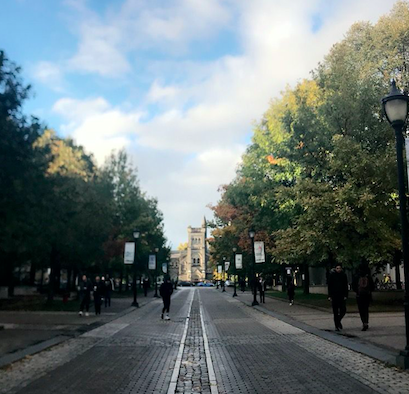Photo Credit: Maria Kotob, Photo Editor
How the pandemic changes the university experience
Aloysius Wong, Associate Opinions Editor
Last spring, my imagination of my fourth year at the University of Toronto (U of T) consisted of many romanticized scenarios: Orientation Week spent welcoming first years and reminiscing with old friends; intimate discussions with fellow students in seminar courses and campus cafés; anticipating waves of nostalgia at my last class, last shift at work, last day as an undergraduate student on campus. It would have been an opportunity to bring closure to the many roles and relationships I had inhabited and developed throughout my time here. Of course, this would all change when the COVID-19 pandemic hit.
Over the summer and in the first few weeks of the semester, I’ve reflected a lot about the shift to online learning and socializing, and how it has radically affected what attending university means. I was the sort of student that found a sense of solace and belonging in the communities of colleges, clubs, and classrooms in my first three years. Now, the focus seems to be much more individual — keeping yourself healthy, on-track with coursework, and in touch with your friends. This has the benefit of making learning more self-sufficient, but for many who relied on the support network university life could offer, it can make living as a student much more difficult than it already is.
Gone, for example, are many of the classroom social dynamics we took for granted. Logging onto Zoom or Bb Collaborate puts you in a grid next to all the other students, with no options to sit at the front or back of the room, or with a group of friends. Any conversations before or after a class or meeting are with everyone in the call, not just with the person next to you, and as a result, check-ins tend to come off as more scripted and impersonal. A Psychology Today article describes this disembodiment well, stressing the physical and emotional discomfort of “the new requirement to join a grid of talking heads on a regular basis, sitting uncomfortably at attention for sometimes hours on end.”
The same seems to hold for extracurricular and social events, with larger ones especially prone to not only more technical difficulties as the number of participants rise, but also replicating the social distance we already practice in public. This makes it much easier to zone out; Gershman describes this as a magnification of the Ringelmann effect, in which larger groups reduce an individual’s sense of personal responsibility. She describes the pattern as follows: “The less you feel needed, the more distracted you will become, and the less you will give to the meeting. And the less you give, the less fulfilling the experience.” Overall, it seems, this leaves us with a conclusion that is equal parts empowering and terrifying: our sense of fulfillment from the university experience, especially now, depends on how much we are willing and able to give.
This all creates some understandable cynicism as to the value of higher education, especially amid a pandemic. To paraphrase the titular character in Good Will Hunting, we can wonder if we’re just “dropping $150 grand on an education we could’ve gotten for $1.50 in late fees at the public library.” What distinguishes higher education from a public library membership, after all, is the opportunity for interaction — the connections, conversations, and friendships we form by embarking on these journeys together. Creating and maintaining these things now requires much more time and energy, but they are critical to our mental health and overall experience of education.
Getting through this pandemic in a way that preserves our identity as students of a university — of a community — will require active intention and dedication from each of us. I can only hope that we will be able to draw up enough collective strength necessary to do so.


